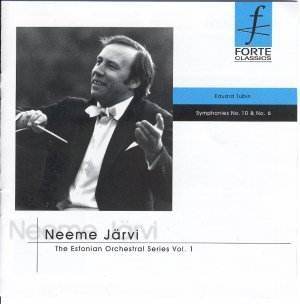At last the 1962 Melodiya recording of the Sixth is available!
This disc has been around since 1999 and little attention
has been paid to it. The original 1962 Melodiya LP of No. 6 is extremely
rare; practically as rare as the Tauno Hannikainen Melodiya of the Sibelius
Lemminkainen Legends or the 78s of Holbrooke's Fourth Symphony
with the Torbay Municipal Orchestra. I wondered if I would ever hear
this version.
The Symphony No. 6 is well represented on another Järvi-conducted
CD and in 1986 stereo on BIS-CD-304. Doggedly trudging, insinuatingly
sinister, aggressive to the point of fury (like one of Rosenberg's angrier
outbursts but even more so), touched with the cold searing acid of Vaughan
Williams' Symphonies 4 and 6 (and with saxophone lines to match), austere
and uncompromising and resolutely unlike Shostakovich. One of its forebears
is The Rite of Spring. Interesting how towards the end of the
second movement Tubin shadows the triumphal moments in the Panufnik
Tragic Overture. In 1986 Järvi and the Swedish Radio SO
took 8.37; 10.02; 12.39 as against 9.11; 9.13 and 14.06 in 1962 on this
disc. There is no escaping the advantages of the splendidly three-dimensional
BIS recording but the chaffing, bladed 'chug-chug' of the first movement
comes across with that extra atmosphere in the Tallinn radio studio.
The nihilistic 'Northern Lights' theme (also used in his second piano
sonata and the ballet Kratt) glows out more balefully with the
Estonians who are also assisted by the more primevally consonant warble
of the Russian style horns. The Sixth is a work of much quietly shuddering
propulsion. Noisy outbursts are to the minimum but listen out for the
balefully guttural trombone howls (à la Pettersson) at the end
of the Molto Allegro. Ultimately this Artists Only! Forte Classics
release is for the Scandinavian music connoisseur with ears case-hardened
by years of listening to multi-generation tape copies. To such a person
the clarity will seem magnificent and they will want to play No. 6,
as I have, at full blast.. By the way the concert premiere of this work
was given by the Stockholm Phil conducted by that grand Beethovenian
and longtime Hamburg resident, Hans Schmidt-Isserstedt, on 31 October
1956.
The Tenth is Tubin's last completed symphony, written
four years after No. 9. It is a single movement piece intriguingly contemporaneous
with the single movement Fifth (and final) symphony by William Alwyn.
Tubin does not toy with atonalism. He is as steadfast to his language
as Holmboe and Rubbra across the span of their symphonies. The work
was commissioned by the Gothenburg SO and completed on 4 April 1973.
Its lyrical impulse is ruffled and disrupted by a memorable stamping
forward movement typical of Miaskovsky and coincidentally related to
the rhythmic pattern that drives forward Louis Glass's Fifth Symphony.
The work is much taken up with music for the French horn and with highly
atmospheric writing for woodwind and 'pressure cooker' string writing
of an overwrought intensity more usually associated with the wartime
works of Schuman and Harris and with the glassy expanses of Sibelius
7. It plays for over 26 minutes. The sessions for No 10 took place months
before Järvi departed Soviet Estonia forever for the USA. The Soviet
authorities then set about the systematic destruction of evidence of
Järvi's existence. Tapes and masters were destroyed . It was only
through the efforts of valiant friends at the Tallinn studios that these
recordings survived as they were carefully mislabelled and hidden. Järvi
also recorded this Symphony for BIS and as far as I can recall the liveliness
and space of the BIS recording of No. 6 also applies to their No. 10.
These are extremely valuable recordings encoding the
music as it arose hot from the composer's pen and amongst the forces
for which it was originally written. If the 1979 analogue taping lacks
the transparency and concussion of a modern digital version it compromises
nothing in the sense of being there.
Rob Barnett
AVAILABILITY
The US Distributors do not offer mail order or direct order services.
All their CDs are reported available in retail stores and internet retailers
such as Amazon.com, TowerRecords.com, and CDNow.com. $11.98 is the suggested
list price for retailers. Artists Only! only have North American rights
for this CD from the Estonian FORTE label.
Further details from distributors:-Artists Only! Records
West Coast Office
9644 Lochinvar St
Pico Rivera
CA90660
phone 562 948 3008
fax 562 948 2608
www.artistsonly.com

![]() Estonian National SO (Sym
10); Estonian Radio SO (Sym 6)
Estonian National SO (Sym
10); Estonian Radio SO (Sym 6)![]() FORTE CLASSICS AOR-16 [58.35]
FORTE CLASSICS AOR-16 [58.35]